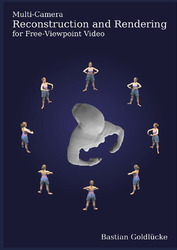| Departments | |
|---|---|
| Book Series (96) |
1378
|
| Nachhaltigkeit |
3
|
| Gesundheitswesen |
1
|
| Humanities |
2367
|
| Natural Sciences |
5406
|
| Mathematics | 229 |
| Informatics | 319 |
| Physics | 980 |
| Chemistry | 1363 |
| Geosciences | 131 |
| Human medicine | 243 |
| Stomatology | 10 |
| Veterinary medicine | 108 |
| Pharmacy | 147 |
| Biology | 835 |
| Biochemistry, molecular biology, gene technology | 121 |
| Biophysics | 25 |
| Domestic and nutritional science | 45 |
| Agricultural science | 1004 |
| Forest science | 201 |
| Horticultural science | 20 |
| Environmental research, ecology and landscape conservation | 148 |
| Engineering |
1793
|
| Common |
98
|
|
Leitlinien Unfallchirurgie
5. Auflage bestellen |
|
Advanced Search
Multi-Camera Reconstruction and Rendering for Free-Viewpoint Video (English shop)
Bastian Goldlücke (Author)Preview
Table of Contents, Datei (45 KB)
Preface, Datei (46 KB)
Extract, Datei (120 KB)
While virtual environments in interactive entertainment become more and more lifelike and sophisticated, traditional media like television and video have not yet embraced the new possibilities provided by the rapidly advancing processing power. In particular, they remain as non-interactive as ever, and do not allow the viewer to change the camera perspective to his liking. The goal of this work is to advance in this direction, and provide essential ingredients for a free-viewpoint video system, where the viewpoint can be chosen interactively during playback. Knowledge of scene geometry is required to synthesize novel views. Therefore, we describe 3D reconstruction methods for two distinct kinds of camera setups. The first one is depth reconstruction for camera arrays with parallel optical axes, the second one surface reconstruction, in the case that the cameras are distributed around the scene. Another vital part of a 3D video system is the interactive rendering from different viewpoints, which has to perform in real-time. We cover this topic in the last part of this thesis.
Während die virtuellen Welten in interaktiven Unterhaltungsmedien immer realitätsnäher werden, machen traditionellere Medien wie Fernsehen und Video von den neuen Möglichkeiten der rasant wachsenden Rechenkapazität bisher kaum Gebrauch. Insbesondere mangelt es ihnen immer noch an Interaktivität, und sie erlauben dem Konsumenten nicht, elementare Parameter wie zum Beispiel die Kameraperspektive seinen Wünschen anzupassen. Ziel dieser Arbeit ist es, die Entwicklung in diese Richtung voranzubringen und essentielle Bausteine für ein Videosystem bereitzustellen, bei dem der Blickpunkt während der Wiedergabe jederzeit völlig frei gewählt werden kann. Um neue Ansichten synthetisieren zu können, ist zunächst Kenntnis von der 3D Geometrie der Szene notwendig. Wir entwickeln daher Rekonstruktionsalgorithmen für zwei verschiedene Anordnungen von Kameras. Falls die Kameras eng beieinanderliegen und parallele optische Achsen haben, können lediglich Tiefenkarten geschätzt werden. Sind die Kameras jedoch im einer Halbkugel um die Szene herum montiert, so rekonstruieren wir sogar echte Oberflächengeometrie. Ein weiterer wichtiger Aspekt ist die interaktive Darstellung der Szene aus neuen Blickwinkeln, die wir im letzten Teil der Arbeit in Angriff nehmen.
| ISBN-13 (Printausgabe) | 3865376398 |
| ISBN-13 (Hard Copy) | 9783865376398 |
| ISBN-13 (eBook) | 9783736916395 |
| Language | German |
| Page Number | 172 |
| Edition | 1 Aufl. |
| Volume | 0 |
| Publication Place | Göttingen |
| Place of Dissertation | Saarbrücken |
| Publication Date | 2005-10-24 |
| General Categorization | Dissertation |
| Departments |
Informatics
|








